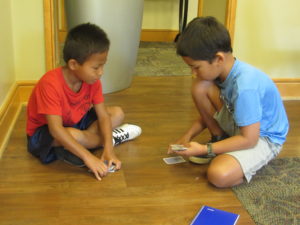SAVY 2019: Session 6, Day 2 – Games Galore (Rising 1st/2nd)
This has been another fantastic day at SAVY! We began our morning with another “Guess Again” game. Inside a paper bag are items that are the same, but the colors may be different. There is one person who gets to be the guesser and another who writes down, “what we know to be true”. This helps the guesser keep track of what has been drawn and what is still possible to be drawn. The guesser must reach into the bag, without looking, and tell the class how many items are in the bag, and describes the shape of the items. Next, the guesser gets to predict the color that will be drawn first, and then reaches into the bag, without looking, and pulls out the first item and shows it to the group. The recorder records the color. The guesser then continues until he or she things they are ready to guess. Our guesser today, began by telling the class that there were 5 items and they all felt like the shape of a square (recorder then wrote this info on the board). The guesser began the challenge of predicting and finally he was ready to say that there were 2 greens, 1 yellow, 1 blue and 1 red. He was absolutely correct! This activity gets students to pay close attention and think odds. Tomorrow we will have another Guess Again.
 Next we discussed this question, “How does the number of times played impact the odds/chance of winning?” Everyone thought that the more you play a game, theoretically, the greater the chance of winning. Although, several thought because of chance, that might not happen. We looked at our data on when we played three games of War, and flipped coins with increasingly more pennies, and it did seem that increased playing might result in a greater chance of winning. We will continue to explore this question.
Next we discussed this question, “How does the number of times played impact the odds/chance of winning?” Everyone thought that the more you play a game, theoretically, the greater the chance of winning. Although, several thought because of chance, that might not happen. We looked at our data on when we played three games of War, and flipped coins with increasingly more pennies, and it did seem that increased playing might result in a greater chance of winning. We will continue to explore this question.
Next, we looked at fractions; what they are, what they represent, how to write them, and how they can be used to determine probability of games. We connected fractions to the coin toss, and then to marbles of different colors. We began to see how fractions can easily represent probability and this was an exciting discovery! One example we used was, 4 marbles: 1 yellow, 1 blue, 1 red and 1 white. We said that the total whole was 4 marbles and each color had a ¼ chance of being grabbed from a bag, theoretically. We then looked at the probability of 4 marbles: 2 white, 1 yellow, and 1 blue and then we saw how the odds changed in the favor of grabbing white. When we experimented with this, we did draw white more often (theoretical), but other colors were grabbed too (experimental/chance). We then practiced with other fractions and probabilities to solidify understanding.
Next, we did the centers we didn’t get to yesterday due to the rain, so we were able to do all four. This experiment was: Odd/Even using different spinners and dice. We gathered all of our data as a class by joining all of our date in one chart. Then we evaluated our outcomes and sought to identify learning. After finishing our Odd-Even synthesis, we began making our own practice game boards and played a game. Students made two different spinners (4 parts, 6 parts, 8 parts), and each player got to choose which spinner they wanted to use in the game. As always, we looked at the math to discern pros and cons of each type of spinners. Tomorrow we continue looking at fairness and how to build it into a game that we create.
Can’t wait!
Karen Tyson
Leave a Response